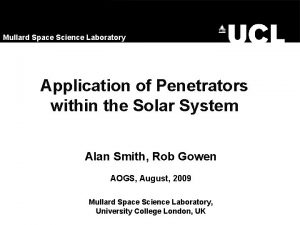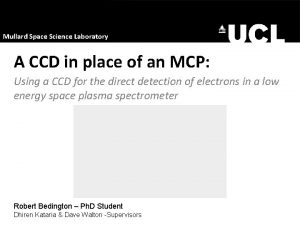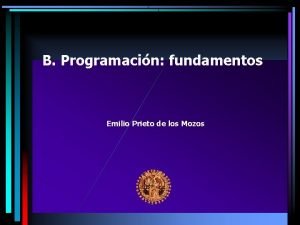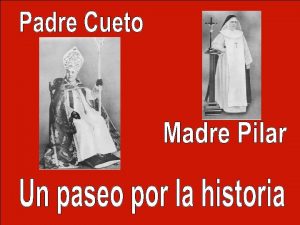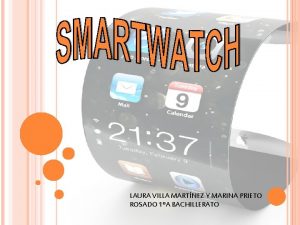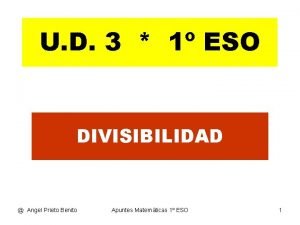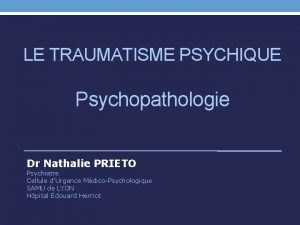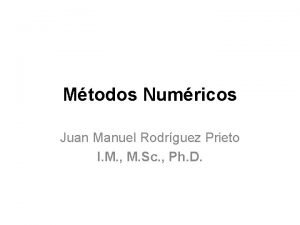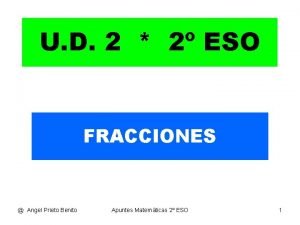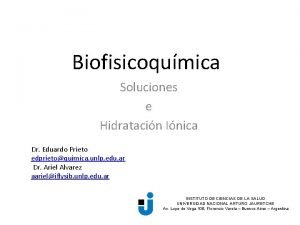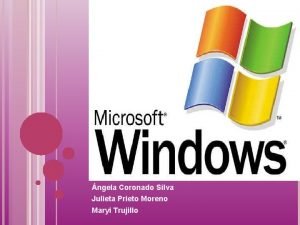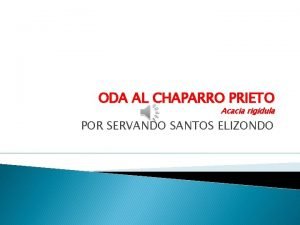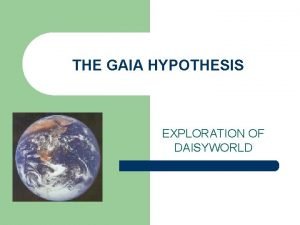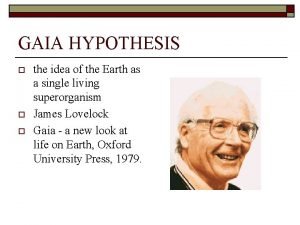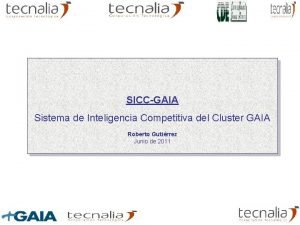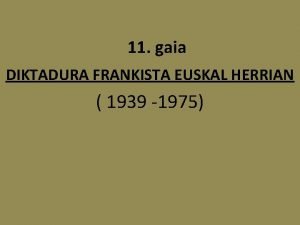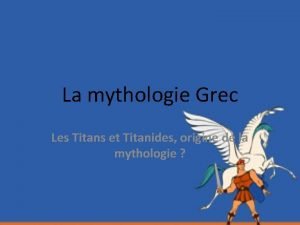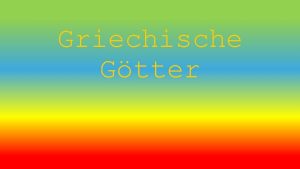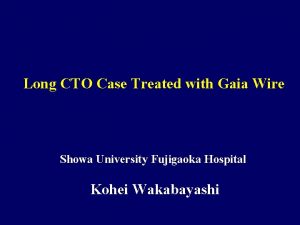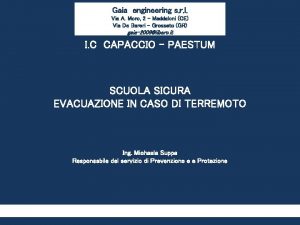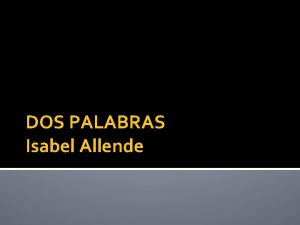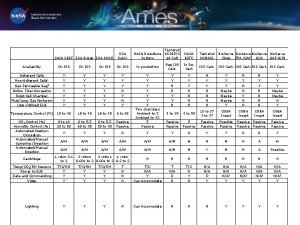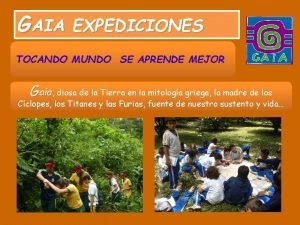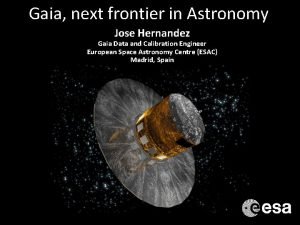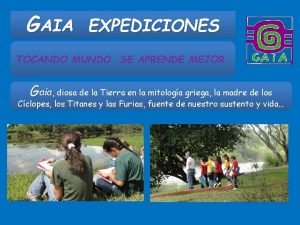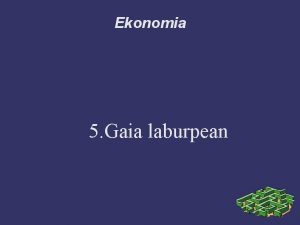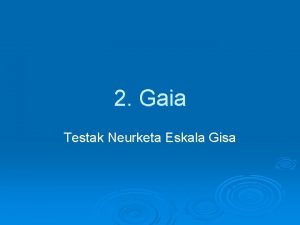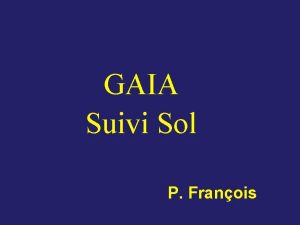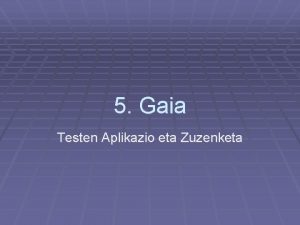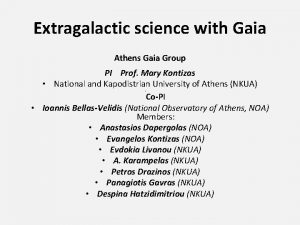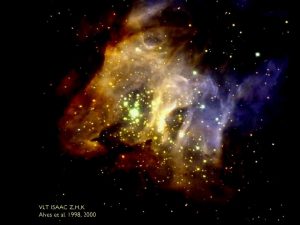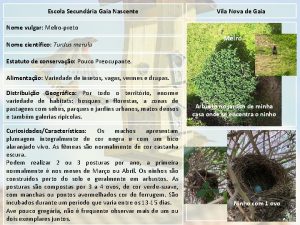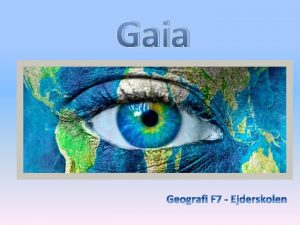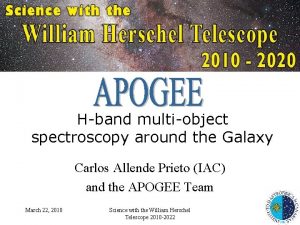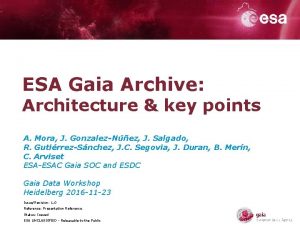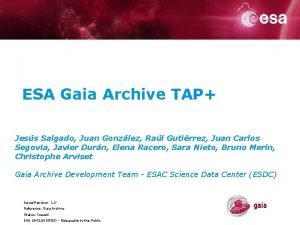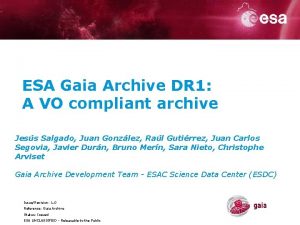The ESA mission Gaia Carlos Allende Prieto Mullard





















![(Spectro-)photometry ILLIUM algorithm (Bailer-Jones 2008). Dwarfs: G=15 ([Fe/H])=0. 21 (Teff)/Teff=0. 005 G=18. 5 ([Fe/H])=0. (Spectro-)photometry ILLIUM algorithm (Bailer-Jones 2008). Dwarfs: G=15 ([Fe/H])=0. 21 (Teff)/Teff=0. 005 G=18. 5 ([Fe/H])=0.](https://slidetodoc.com/presentation_image/31ba2a083da6c1b5e2c5cb939e6c07d8/image-22.jpg)













- Slides: 35

The ESA mission Gaia Carlos Allende Prieto Mullard Space Science Laboratory University College London

Gaia’s Three Elements Astrometry (V < 20) completeness to 20 mag 109 stars accuracy: 10– 25 arcsec at 15 mag scanning satellite, two viewing directions principles: global astrometric reduction (as for Hipparcos) Photometry (V < 20) Low-dispersion spectrophotometry 0. 3 - 1 m Radial velocity (V < 16– 17) slitless spectroscopy near Ca II triplet (847– 874 nm) third component of space motion, perspective acceleration dynamics, population studies, binaries spectra: chemistry, rotation

Gaia: Complete, Faint, Accurate Quasars Radial vel. Target selection

Stellar Astrophysics Parallaxes and photometry imply a comprehensive luminosity calibration distances to 1% for ~10 million stars to 2. 5 kpc distances to 10% for ~100 million stars to 25 kpc parallax calibration of all distance indicators e. g. Cepheids and RR Lyrae to LMC/SMC accurate parallaxes accurate surface gravities and age

Stellar Astrophysics An unbiased survey implies a detailed Galactic census solar neighbourhood mass function and luminosity function e. g. white dwarfs (~200, 000) and brown dwarfs (~50, 000) initial mass and luminosity functions in star forming regions rare stellar types and rapid evolutionary phases in large numbers Statistics on variability across the board (~40 (RVS) - 100 (AS, XP) visits per object)

One Billion Stars in 6 -d will Provide … in our Galaxy … the distance and velocity distributions of all stellar populations a rigorous framework for stellar structure and evolution theories a large-scale survey of extra-solar planets (~20, 000) a large-scale survey of Solar System bodies (~ few 100, 000) … and beyond definitive distance standards out to the LMC/SMC rapid reaction alerts for supernovae and burst sources (~20, 000) QSO detection, redshifts, microlensing structure (~500, 000) fundamental quantities to unprecedented accuracy: to 10 -7 (10 -5 present)

Exo-Planets: Expected Discoveries Astrometric survey: monitoring of hundreds of thousands of FGK stars to ~200 pc detection limits: ~1 MJ and P < 10 years masses, rather than lower limits (m sin i) multiple systems measurable, giving relative inclinations Results expected: ~20, 000 exo-planets (~10 per day) orbits for ~5000 systems masses down to 10 MEarth to 10 pc >1000 photometric transits Figure courtesy François Mignard

Studies of the Solar System Asteroids etc. : deep and uniform (20 mag) detection of all moving objects ~ few 100, 000 new objects expected (357, 614 with orbits presently) taxonomy/mineralogical composition versus heliocentric distance diameters for ~1000, masses for ~100 orbits: 30 times better than present Trojan companions of Mars, Earth and Venus Kuiper Belt objects: ~300 to 20 mag (binarity, Plutinos) Near-Earth Objects: Amors, Apollos and Atens (2249, 2643, 406 known today) ~1600 Earth-crossers >1 km predicted (937 currently known) detection limit: 260– 590 m at 1 AU, depending on albedo Movie courtesy of Jos de Brujne


Satellite and System • ESA-only mission • Launch date: 2011 • Launcher: Soyuz–Fregat • Orbit: L 2 • Lifetime: 5 years • Ground station: New Norcia and Cebreros • Downlink rate: 4– 8 Mbps • Mass: 2120 kg (payload 700 kg) • Power: 1720 W (payload 735 W) Figures courtesy EADS-Astrium

Payload

Payload and Telescope Two Si. C primary mirrors 1. 45 0. 50 m 2 at 106. 5° Rotation axis (6 h) Basic angle monitoring system Si. C toroidal structure (optical bench) Superposition of two Fields of View (Fo. V) Figure courtesy EADS-Astrium Combined focal plane (CCDs)

Figure courtesy Alex Short Focal Plane 104. 26 cm 42. 35 cm Basic Angle Monitor Red Photometer CCDs Wave Front Sensor Blue Photometer CCDs Wave Front Sensor Radial-Velocity Spectrometer CCDs Star motion in 10 s Sky Mapper CCDs Total field: Astrometric Field CCDs Sky mapper: - detects all objects to 20 mag - active area: 0. 75 deg 2 - rejects cosmic-ray events - CCDs: 14 + 62 + 14 + 12 - Fo. V discrimination - 4500 x 1966 pixels (TDI) - pixel size = 10 µm x 30 µm Astrometry: = 59 mas x 177 mas - total detection noise: ~6 e- Photometry: - spectro-photometer - blue and red CCDs Spectroscopy: - high-resolution spectra - red CCDs

On-Board Object Detection Requirements: unbiased sky sampling (mag, colour, resolution) all-sky catalogue at Gaia resolution (0. 1 arcsec) to V~20 Solution: on-board detection: good detection efficiency to V~21 mag FPA CCDs generate Gbps windows

Sky Scanning Principle 45 o Spin axis Scan rate: Spin period: Figure courtesy Karen O’Flaherty 45 o to Sun 60 arcsec/s 6 hours

Astrometric Data Reduction Principles Scan width: 0. 7° Sky scans (highest accuracy along scan) Figure courtesy Michael Perryman 1. Object matching in successive scans 2. Attitude and calibrations are updated 3. Objects positions etc. are solved 4. Higher terms are solved 5. More scans are added 6. System is iterated

Light Bending in Solar System Light bending in microarcsec, after subtraction of the much larger effect by the Sun Movie courtesy Jos de Bruijne


Photometry Measurement Concept Blue photometer: 330– 680 nm Red photometer: 640– 1000 nm Figures courtesy EADS-Astrium

Photometry Measurement Concept RP spectrum of M dwarf (V=17. 3) Red box: data sent to ground White contour: sky-background level Colour coding: signal intensity Figures courtesy Anthony Brown

Ideal tests Shot, electronics (readout) noise Synthetic spectra Logg fixed (parallaxes will constrain luminosity) G=18. 5 G=20 Bailer-Jones 2009 GAIA-C 8 -TN-MPIA-CBJ-043 S/N per pixel
![Spectrophotometry ILLIUM algorithm BailerJones 2008 Dwarfs G15 FeH0 21 TeffTeff0 005 G18 5 FeH0 (Spectro-)photometry ILLIUM algorithm (Bailer-Jones 2008). Dwarfs: G=15 ([Fe/H])=0. 21 (Teff)/Teff=0. 005 G=18. 5 ([Fe/H])=0.](https://slidetodoc.com/presentation_image/31ba2a083da6c1b5e2c5cb939e6c07d8/image-22.jpg)
(Spectro-)photometry ILLIUM algorithm (Bailer-Jones 2008). Dwarfs: G=15 ([Fe/H])=0. 21 (Teff)/Teff=0. 005 G=18. 5 ([Fe/H])=0. 42 (Teff)/Teff=0. 008 G=20 ([Fe/H])=1. 14 (Teff)/Teff=0. 021 G=20

Radial Velocity Measurement Concept Spectroscopy: 847– 874 nm (resolution 11, 500) Figures courtesy EADS-Astrium

RVS grating 20. 5 x 15. 5 cm 302. 11 grooves/mm Wavefront error < 8 nm rms >80% efficiency 847 -874 nm ©Fraunhofer Institut fur Optik und Feinmechanik

Radial Velocity Measurement Concept Field of view RVS spectrograph CCD detectors RVS spectra of F 3 giant (V=16) S/N = 7 (single measurement) S/N = 77 (40 x 3 transits) Figures courtesy David Katz

RVS S/N ( per transit and ccd) 3 window types: G<7, 7<G<10 (R=11, 500), G>10 (R~4500) √ (S + rdn 2) Most of the time RVS is working with S/N<1 End of mission spectra will have S/N > 10 x higher G magnitude Allende Prieto 2009, GAIA-C 6 -SP-MSSL-CAP-003

Sample RVS spectra (mission end, black line) G=10. 5 G=12. 3 G=15. 8 B 5 V G 2 V Metalpoor K 1 III Allende Prieto 2009

RVS produce Radial velocities down to V~17 (108 stars) Atmospheric parameters (including overall metallicity) down to V~ 13 -14 (several 106 stars) Chemical abundances for several elements down to V~12 -13 (few 106 stars) Extinction (DIB at 862. 0 nm) down to V~13 (e. g. Munari et al. 2008) ~ 40 transits will identify a large number of new spectroscopic binaries with periods < 15 yr (CU 4, CU 6, CU 8)

RV performance V(mag) 11 13. 5 17 Spec. for late-type stars 1 km/s at V<13 15 km/s down to V=17 Latest performance estimates

Atmospheric parameters (Ideal tests) Solid: absolute flux Dashed: absolute flux, systematic errors (S/N=1/20) Dash-dotted: relative flux Allende Prieto (2008)

Scientific Organisation Gaia Science Team (GST): 7 members + ESA Project Scientist + DPAC Executive Chair Scientific community: organised in Data Processing and Analysis Consortium (DPAC) All software written in JAVA (two populations) ~375 scientists in 16 countries active at some level Community is active and productive: regular science team/DPAC meetings growing archive of scientific reports advance of simulations, algorithms, accuracy models, etc. Data distribution policy: final catalogue ~2019– 20 intermediate catalogues as appropriate science alerts data released immediately no proprietary data rights

Data Processing (simplified) From ground station Overall system architecture ESAC Object processing + Classification CNES, Toulouse Ingestion, pre-processing, data base + versions, astrometric iterative solution ESAC + Barcelona + OATo Photometry Cambridge (Io. A) + Variability Geneva (ISDC) Data simulations Barcelona Spectroscopic processing CNES, Toulouse

Status and Schedule Prime contractor: EADS-Astrium implementation phase started early 2006 preliminary design review completed June 2007 CDR in early 2010 (now delayed a few months to mid-2010) Main challenges: CCDs and FPA (including proximity electronics) Si. C primary mirrors scientific calibration of CCD radiation-damage effects Schedule: no major identified uncertainties to affect cost or launch schedule launch in December 2011

Schedule 2004 2000 2008 2016 2012 2020 Concept & Technology Study (ESA) ESA Acceptance Re-assessment: Ariane-5 Soyuz Technology Development Design, Build, Test Launch Cruise to L 2 Observations Data Analysis Early Data Catalogue

 Rob mullard
Rob mullard Mullard space science laboratory
Mullard space science laboratory Esa multimedia.esa.int./multimedia/virtual-tour-iss
Esa multimedia.esa.int./multimedia/virtual-tour-iss Dos palabras isabel allende
Dos palabras isabel allende Isabel allende la mujer del juez
Isabel allende la mujer del juez Felizmente sola
Felizmente sola Dos palabras isabel allende preguntas
Dos palabras isabel allende preguntas Clarisa isabel allende summary
Clarisa isabel allende summary Isabel allende
Isabel allende Isabel allende escribir es igual que enamorarse
Isabel allende escribir es igual que enamorarse Emilio prieto de los mozos
Emilio prieto de los mozos Madre pilar prieto vidal op
Madre pilar prieto vidal op Smartwatch reloj
Smartwatch reloj Angel prieto
Angel prieto Nathalie prieto
Nathalie prieto Joaquin prieto
Joaquin prieto Regla del trapecio
Regla del trapecio Ainhoa prieto
Ainhoa prieto 3,141596
3,141596 Isvv
Isvv Solución
Solución Jose joaquin prieto
Jose joaquin prieto Familia prieto moreno
Familia prieto moreno Chaparro prieto
Chaparro prieto Cupcakes business description
Cupcakes business description The gaia hypothesis
The gaia hypothesis Gaia hypothesis examples
Gaia hypothesis examples Cluster gaia
Cluster gaia Gaia fund
Gaia fund 11. gaia diktadura frankista euskal herrian
11. gaia diktadura frankista euskal herrian Que es gaia segun mago de oz
Que es gaia segun mago de oz Titan mythologie grecque
Titan mythologie grecque Griechische göttin erde
Griechische göttin erde Gaia expediciones
Gaia expediciones Gaia second wire
Gaia second wire Gaia engineering
Gaia engineering
